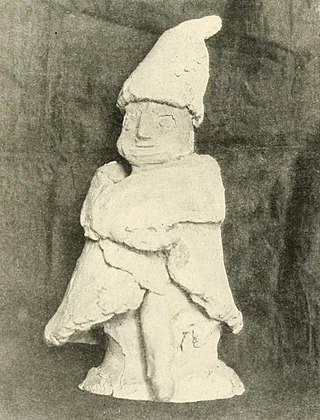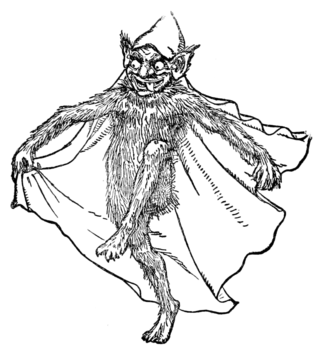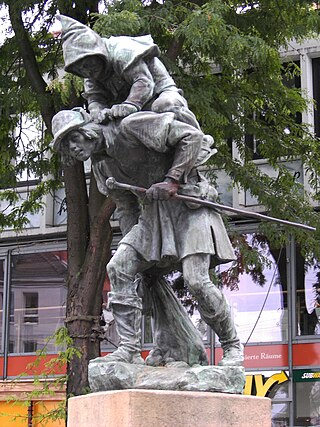Related Research Articles

A kobold is a mythical sprite. Having spread into Europe with various spellings including "goblin" and "hobgoblin", and later taking root and stemming from Germanic mythology, the concept survived into modern times in German folklore.

A household deity is a deity or spirit that protects the home, looking after the entire household or certain key members. It has been a common belief in paganism as well as in folklore across many parts of the world.

"Frau Holle" is a German fairy tale collected by the Brothers Grimm in Children's and Household Tales in 1812. It is of Aarne-Thompson type 480.

A lutin is a type of hobgoblin in French folklore and fairy tales. Female lutins are called lutines.
Mythic humanoids are legendary, folkloric, or mythological creatures that are part human, or that resemble humans through appearance or character. Each culture has different mythical creatures that come from many different origins, and many of these creatures are humanoids. They are often able to talk and in many stories they guide the hero on their journey.

A goblin is a small, grotesque, monstrous creature that appears in the folklore of multiple European cultures. First attested in stories from the Middle Ages, they are ascribed conflicting abilities, temperaments, and appearances depending on the story and country of origin, ranging from mischievous household spirits to malicious, bestial thieves. They often have magical abilities similar to a fairy or demon, such as the ability to shapeshift.

The Schrat or Schratt, also Schraz or Waldschrat, is a rather diverse German legendary creature with aspects of either a wood sprite, domestic sprite and a nightmare demon.

The aufhocker or huckup is a shapeshifter in German folklore.
The Buschgroßmutter is a legendary creature from German folklore, especially found in folktales from the regions Thuringia, Saxony, former German-speaking Silesia and the former German-speaking parts of Bohemia. She is called various regional names such as Pusch-Grohla and Buschmutter in Silesia, 's Buschkathel and Buschweibchen in Bohemia, Buschweiblein and Buschweibel in Silesia again. Buschweibchen, Buschweiblein, and Buschweibel all mean "shrub woman", with Weibchen, Weiblein or Weibel being the diminutive of Weib, "woman".
The Irrwurz, Irrwurzel or Irrkraut is a legendary plant from German-speaking countries. In France it is known as herbe d'égarement among other names.

The Niß Puk or Nis Puk is a legendary creature, a kind of Kobold, from Danish-, Low German- and North Frisian-speaking areas of areas of Northern Germany and Southern Denmark, among them Schleswig, today divided into the German Southern Schleswig and Danish Northern Schleswig. An earlier saying says Nissen does not want to go over the Eideren, i.e. not to Holstein to the South of Schleswig. Depending on the place, it can either appear as a domestic spirit or take on the role of a being generally called Drak or Kobold in Danish and German mythology, an infernal spirit making its owner wealthy by bringing them stolen goods.
The Uhaml is a spirit from German folktales. It was known among the former Germans of Bohemia and Silesia, now part of the Czech Republic and Poland respectively, particularly in the former Iglau language island of Bohemia. The Uhaml is an airy sprite, a ghost, or possibly some kind of demonic bird. Nothing is known about its appearance other than it having horse feet.
The Drak, Drâk, Dråk, Drakel or Fürdrak, in Oldenburg also Drake (f.), is a household spirit from German folklore often identified with the Kobold or the devil, both of which are also used as synonymous terms for Drak. Otherwise it is also known as Drache (dragon) but has nothing much to do with the reptilian monster in general.
The Klagmuhme or Klagemuhme is a female sprite from German folklore also known as Klagmutter or Klagemutter. She heralds imminent death through wailing and whining and is thus the German equivalent of the banshee.
The Fänggen are female wood sprites in German folklore exclusively found in Tyrol.
The witte Wiwer, witte Wîwer, witte Wiewer or witte Wiver are legendary creatures from German folklore similar to but distinct from the weiße Frauen. Other names are unterirdische Weiber in Mecklenburg and Sibyllen in Northwestern Germany.
The Heimchen is a being from German folklore with several related meanings.
The Feuermann, also Brennender, Brünnling, Brünnlinger, Brünnlig, brünnigs Mannli, Züsler, and Glühender is a fiery ghost from German folklore different from the will-o'-the-wisp, the main difference being its size: Feuermänner are rather big, Irrlichter rather small. An often recurring term for Feuermänner is that of glühende Männer.
The Hemann, also Homann, Hoymann, Hoimann, or Jochhoimann,, is a spirit from German folklore known to scare people through yelling, usually invisibly and at night. The first part of its name usually depicts the kind of yell heard from the Hemann. It can be found in former German-speaking Bohemia, former German-speaking Silesia, Upper Palatinate, the Fichtel Mountains, the Vogtland, Westphalia, and around Crailsheim in Baden-Württemberg.
The Gütel is a variant of and synonym for the Kobold in German folklore. Originating in the Middle High German term gütelgüttel signifying an idol, the name was later connected with the adjective gut = good.
References
- 1 2 3 4 5 Ranke (1927): Bieresel. In: Hanns Bächtold-Stäubli, Eduard Hoffmann-Krayer (1927): Handwörterbuch des Deutschen Aberglaubens: Band 1 Aal-Butzemann. Berlin/New York 2000 p. 1282.
- ↑ Thorpe, Benjamin (1852). Northern Mythology, Comparing the Principal Popular Traditions and Superstitions of Scandinavia, North Germany, and the Netherlands , Vol III. London: Edward Lumley.
- ↑ Rose, Carol (1996). Spirits, Fairies, Leprechauns, and Goblins: An Encyclopedia. New York City: W. W. Norton & Company, Inc. ISBN 0-393-31792-7
- ↑ Homer, Johnny. Brewing in Kent. Gloucestershire, Amberlley Publishing, 2016 ISBN 9781445657431.